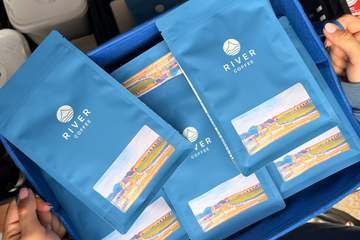Origin Report: Minas Gerais, Brazil
Nov 25, 2025
In November 2025 it was time to pay a visit to Brazil, after last visiting in 2019.
Setting off at 2am to catch the first flight of the morning from Heathrow, I was bound for Belo Horizonte, the capital of one of Brazil’s key coffee-growing regions.
Fifteen hours later, I touched down. As the plane descended, the landscape out the window was a familiar one: vast rolling hills, jagged rocks and winding rivers. This was Minas Gerais which is the largest coffee-producing state in Brazil, accounting for over 50% of the country’s coffee output.
 Split into four key areas, Minas Gerais consists of Cerrado Mineiro, Sul de Minas, Chapada de Minas, and Matas de Minas. If you’ve tried our coffee over the years, you may remember Vinhal Coffee, Rio Brilhante, Sao Luiz, all set in Cerrado Mineiro and Rio Verde from Sul de Minas.
Split into four key areas, Minas Gerais consists of Cerrado Mineiro, Sul de Minas, Chapada de Minas, and Matas de Minas. If you’ve tried our coffee over the years, you may remember Vinhal Coffee, Rio Brilhante, Sao Luiz, all set in Cerrado Mineiro and Rio Verde from Sul de Minas.
This year’s visit was set to be busy. So much has changed in the industry over the past few years: coffee prices have soared over 300% due to climate changes, supply levels are dropping, and Trump-era tariffs continue to cause disruption.
The trip was organised by Sescoop, who represent cooperatives across Brazil. The fundamental purpose of a coffee cooperative is to group producers together to leverage economies of scale. Together, producers can benefit from shared farming costs, such as bulk purchasing of fertilisers. Cooperatives also provide greater marketing opportunities and can facilitate access to finance for smallholders who might struggle to secure loans individually. I connected with 12 of Brazil’s leading coffee-producing cooperatives and had the opportunity to learn about their operations and taste their coffee offerings. These included leaders such as Cooxupe, Cocatrel and Carpec, among others.
It was a fantastic opportunity to learn from leaders of the Brazilian coffee industry and to develop new relationships and contacts in key regions.
 I also visited the Semana Internacional do Café festival, Brazil’s leading coffee festival, a collaboration of coffee producers, specialty roasters, machine companies, all under one roof. I tasted an incredible range of coffees, from award-winning Arabica lots to highly fermented Robustas.
I also visited the Semana Internacional do Café festival, Brazil’s leading coffee festival, a collaboration of coffee producers, specialty roasters, machine companies, all under one roof. I tasted an incredible range of coffees, from award-winning Arabica lots to highly fermented Robustas.
I left with one thought: for years, the industry has spoken about mono-flavoured Brazilian coffee, lacking diversity. I found far from that. This trip opened up a world of flavour diversity, quality, and scale. Brazil has a lot to be excited about.
 The River Coffee Roasters team are working hard behind the scenes to bring these coffees to you. Keep an eye out in 2026 for changes to the components in our Drift, Flow and Blossom blends.
The River Coffee Roasters team are working hard behind the scenes to bring these coffees to you. Keep an eye out in 2026 for changes to the components in our Drift, Flow and Blossom blends.




